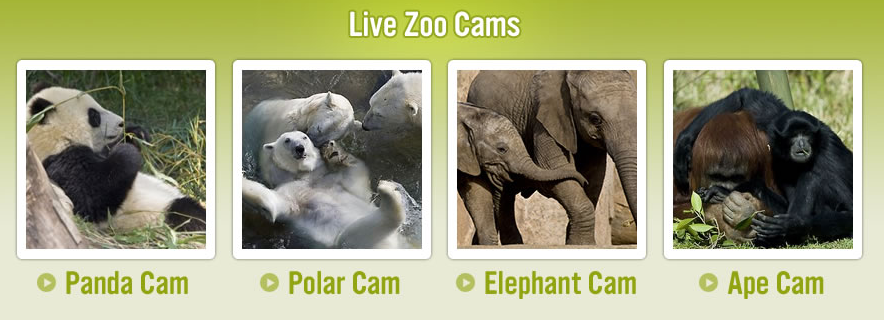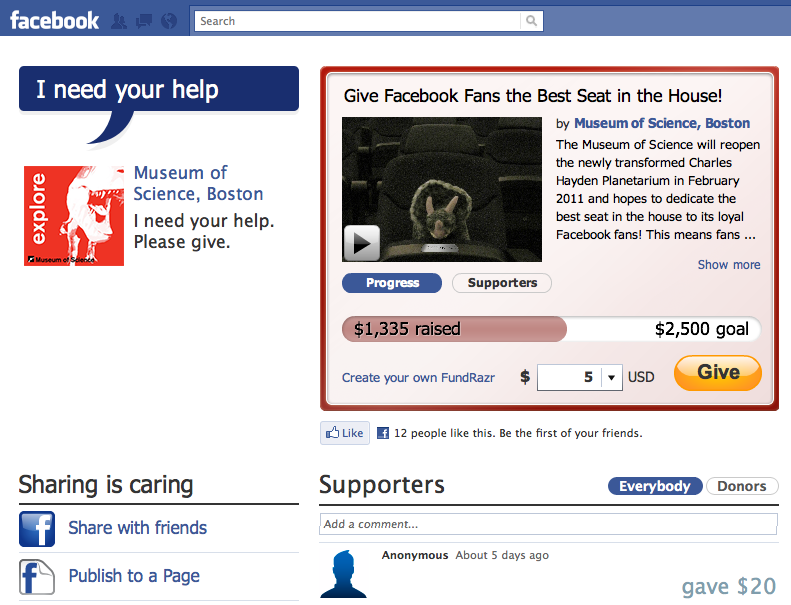38 ways Zoos and Aquariums are engaging people through Social Media

Interested in seeing- at a glance- which zoos and aquariums are using social media (or were by November 20, 2010 at least)? Check out this awesome spreadsheet created by Anthony Brown of the San Francisco Zoo. It lists which zoos and aquariums are using Facebook, Twitter, Flickr, and YouTube, as well as basic engagement stats.
Check out some of the classic, creative, charming, and kooky ways that zoos and aquariums are using social technology to make waves in their communities and beyond:
Utilizing Basic Social Media Building Blocks.
1. Twitter. The Association of Zoos and Aquariums maintains a twitter list with over 127 accredited zoos and aquariums on Twitter. But from the looks of things, there are many, many more than that. Among hundreds of others, you can follow the Oregon Zoo, the California Academy of Sciences, the Seattle Aquarium, the Fort Worth Zoo, the Georgia Aquarium…
2. Facebook. 7% of all humans are on Facebook and zoos and aquariums are effectively using this space to cultivate networks, create interaction, and share information. The Tennessee Aquarium always surprises me with cool facts in my Facebook news feed.
3. Flickr. Holy cow! If there’s one social media platform in which zoos and aquariums are taking the lead, it’s on Flickr. When asked (in a survey I crafted in collaboration with AZA), many zoos and aquariums reported Flickr initiatives as their most innovative uses of social technology. My favorite straight-up use of Flickr? That’s a toughie… but the Shedd Aquarium’s Flickr group is up there.
4. YouTube. There’s so much good stuff here, too. Zoos and Aquariums are mostly using this site to help them give visitors a behind-the-scenes look at the institution. I like the San Diego Zoo’s YouTube channel.
5. Website. Have you noticed that many of the biggest and most visited zoos and aquariums feature links to social media pages above the fold on their websites (even if it’s small)?
6. Interactive Pages. Many zoos and aquariums are putting their web-based social and educational resources in one place. Check out the New England Aquarium’s awesome interaction page.
7. Blogging. The Dickerson Park Zoo’s blog posts and short and sweet- and a lot of fun. Speaking of blogs, the Houston Zoo has four of them. They use fun facts and photos to share information on conservation, education and Trunk Tales, a blog covering elephant news and happenings at the zoo.
8. Mobile Applications. These ones by the Woodland Park Zoo, the Memphis Zoo, and the Dallas Zoo aim to make the visitor experience as comfortable as possible by providing basic information on the zoo and the exhibits. They even feature GPS so you can figure out how to get to your favorite animals.
9. Foursquare. Remember to check in when you visit the Sacramento Zoo. You’ll be rewarded with a free carousel ticket- and the mayor gets a free gift.
10. Virtual Conferences. The Association of Zoos and Aquariums is on top of creating engaging webinars that allow zoo and aquarium professionals to connect and share stories online. Couldn’t make it to the AZA Annual Conference in Houston? No worries.
11. Podcasts. The Aquarium of the Pacific’s (for instance) podcasts share information about the aquarium as well as news and information about issues facing our oceans and our planet. It’s music to an audible learner’s ears.
But that’s not even close to the end of it. Prepare to be inspired… and learn a thing or two about sea creatures, four-legged friends, the environment, and everything in between…
Storytelling and Online Engagement
12. It’s a boy! This baby gorilla was abandoned by its mother, and then had to be raised by hand and trained with a surrogate mother at the San Fransisco Zoo. The sensitive situation meant months of no on-site press. But it was no problem for the zoo. They captured the baby gorilla’s pertinent milestones on video. Everything was filmed and edited internally, uploaded on the Zoo’s YouTube channel and then distributed to the press. It worked beautifully and the press used these video links on their own Web sites and in print. Broadcasters pointed viewers and listeners to the YouTube channel and also aired them during newscasts.
13. Talk about streaming cuteness. The Knoxville Zoo’s creative partnership with the Mozilla Foundation raised awareness of endangered species through a 24 hour live stream of two red pandas (firefoxes). Their names, Ember and Spark, were determined by online voters. I cannot lie: sometimes I open this tab on my browser and check-in throughout the day. It’s that cute. (Please don’t judge…)
14. Meet Essex Ed. Turtle Back Zoo’s resident groundhog, Essex Ed, took over the Zoo’s twitter account during the month of February, expanding his prognostication prowess beyond winter weather predictions. Look out @SUEtheTrex & @NatHistoryWhale.This furry futurist was quite charming (even if his lovable predictions weren’t always correct).
15. Turning print materials into links. The National Aquarium transcends the divide between printed materials and the web by using QR codes on printed materials that link to their YouTube, Facebook, Twitter, or Flickr accounts.
16. Information share within the industry. Impactful nonprofits share their knowledge with others. That’s basically what the San Fransisco Zoo is doing in this video. One thing that I think is cool/important: the zoo doesn’t just leave twitter to the marketing department. They know that many departments should be at least a bit involved.
17. A picture’s worth a thousand words. The Monterey Bay Aquarium holds photo captions contests to engage visitors.
18. Going Meta. The Shedd Aquarium makes celebrating Flickr and Facebook fan engagement through Facebook look easy with their Fan Photo of the Week. They encourage Facebook users to tag themselves in photos in order to vote for their favorite. It’s a genius voting system. When folks tag themselves to vote, it often shows up the newsfeed for people in their networks, spreading the initiative.
19. Live tweeting… from the ocean? The Birch Aquarium at Scripps took the middle-man out of education-based communication when they created a Twitter account specifically for whale-watching season. Their Naturalists tweet live from the boat!
20. Apes, Elephants, Pandas- oh my! The San Diego Zoo invites you to live stream their apes, elephants, pandas and polar bears! And while you’re on the site, try your hand at the Elephant Odyssey Game.
21. No photographer wants to be photo-bombed by strangers. The Aquarium of the Pacific takes Flickr photo contests to another level and uses it to bring folks in the door. They created regular Photography Nights in which photographers (and photographers-in-training) are welcome to take pictures without worrying about the general public.
22. Let’s tweetup! The Houston Zoo conducts so many of them that they have a separate Twitter account for them.
23. We advise you to visit the aquarium. Got a good rating on Trip Advisor thanks to great visitor service efforts? Flaunt it. Word of mouth marketing is thought be to the most trusted and effective form of marketing. Take a lesson from the Oregon Coast Aquarium: link to your ratings on Trip Advisor and make sure folks know how much your visitors love it.
24. Know your assets! In this case, it’s a Great White Shark. Kind of. I dare you to take a look at this Flickr album of enthusiastic visitors to Birch Aquarium at Scripps, and tell me you don’t want to take a picture with this shark.
25. Because “Fluffy’s Daughter” is a bad name for a baby python. And the Columbus Zoo and Aquarium knew it was a lame name, so they called in help from their community. Their naming contest on Facebook resulted in thousands of submissions and 1,200 original names, which were narrowed to five and placed back on Facebook for voting. Talk about well received; more than 500 people voted in the first 20 minutes and the zoo significantly boosted their “likes” on Facebook! (Spoiler: The name “Hanna” won with 816 votes)
26. The good ole’ ‘Fun Fact’ route never goes out of style. Rosamond Gifford Zoo tweets healthy doses of “Today’s Wild Wisdom,” by popular demand from their online community. A little bit (more) proof that social media works best when educational or exciting information is shared… and not just used as an announcement board for holiday closures.
27. Calling all ‘Mommy Group Organizers!’ Using the social tool Meetup.com, the San Diego Zoo makes it easy to set up playdates at the zoo.
28. Are you on Jumo? The Palm Beach Zoo has a page. No pressure.
29. Cell phone audio guides are a classic. At the Florida Aquarium, kids can listen to birds, fish, alligators, and otters through a cell phone audio guide.
30. State lines are for dummies. The Columbus Zoo offers special distance learning classes to K-12 kids across the country. The program “brings the zoo to you” using standard audio/video teleconferencing equipment.
Fundraising, Working the Market, and Strategic Uses of Social Media
31. Mobile devices= tools for donations. The Cameron Park Zoo launched a mobile giving campaign, which allows guests to donate $5 or $10 via text message. .
32. Making fundraising social with new tools. The Museum of Science in Boston uses Fundrazr, a social fundraising tool, to raise funds. In fact, the museum has raised over $2500 for the renovation of the Charles Hayden Planetarium exclusively through its network of online followers.
33. Meet the parents. The Knoxville Zoo knows who makes up a big part of their market- and they utilize a local online social resource called knoxmoms.com to connect with parents in the area.
34. Zoos vs. Aquariums: Who does it better? The National Mississippi River Museum and Aquarium is already rocking the contests tab on their Facebook page to engage audiences- but one of their greatest contests featured a friendly race that pitted them against the Blank Park Zoo in Des Moines, IA. The race was to see which one–Aquarium or Zoo–could promote their page in order to get the most new likes/fans for their respective Facebook page by the end of the contest on October 31, 2010. It was close, but in the end, the aquarium lost and had to do a full day of “dirty jobs” for the zoo. But both organizations were winners in the end because of the increase in fans resulting from the competition. The Aquarium increased it’s Facebook fan base by 283%!
35. A collaboration to strengthen community. The Cheyenne Mountain Zoo partnered with the Division 1 college hockey team in town, the Tigers, to promote both partners’ community-strengthening missions. They agreed to publicize for one another through their social media channels. In exchange, the Tigers promoted the zoo by showing video footage of the zoo’s tigers during period breaks, on the concourse, and on TV big screens at games. The zoo and the hockey team also conducted a successful meet-and-greet with players at the zoo, all the while shouting out to one another and publicizing these events through social media.
36. Make it easier for fans to give. In celebration of National Adoption Day, the Rosamond Gifford Zoo did a two-day promotion in which they significantly discounted their Adopt-an-Animal program. They created a custom package that was smaller than a traditional package (and therefore less expensive for us to produce). The result? An easy way to make an additional $350 for the program while getting the word out and giving their online community a sense of special perks.
37. Don’t forget gift shop sales! Folks at Clyde Peelings Reptiland say that Facebook is their favorite way to promote new items in their gift shop.
38. Tapping social technology for active feedback. The first step in evolving in order to best need visitor needs is to know what those needs are. By listening to audiences on social media, organizations can learn a lot about those needs- but the Brevard Zoo is taking an even more direct approach. They created research site that asks visitors how the museum can improve. The site allows them to get active feedback, create focus groups, and engage in private forums.
Do you know of any zoos and aquariums utilizing social technology to engage audiences in ways that aren’t mentioned here? Share them in the comments section and add them to the list!











